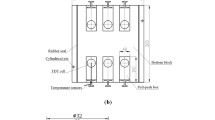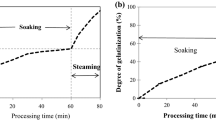Abstract
High-moisture snacks, such as steamed buns and rice cakes, are traditional and popular in Asian countries. However, their shelf life is short, primarily due to microbial spoilage. Current manufacturing methods address this shortcoming through the use of chemical preservatives. To satisfy consumers’ demand for preservative-free food, thermal sterilisation of a model high-moisture snack (steamed rice cakes) is investigated in this work. Bacillus cereus spores are heat-resistant pathogens typically found in rice products; hence, they constitute a suitable candidate to assess the effectiveness of thermal sterilisation. A validated combination of predicted temperature profile of rice cakes based on thermal properties extracted experimentally with thermal inactivation kinetics of B. cereus spores allows us to assess the sensitivity of processing conditions to sterilisation efficiency. Using both experimentation and modelling, it is shown that enhancement of heat transfer by improving convection from the heating medium (either water or steam) has a limited effect on inactivation due to the intrinsic kinetics of spore inactivation.






Similar content being viewed by others

References
Abdul Ghani, A. G., Farid, M. M., Chen, X. D., & Richards, P. (1999). An investigation of deactivation of bacteria in a canned liquid food during sterilization using computational fluid dynamics (CFD). Journal of Food Engineering, 42(4), 207–214.
Abdul Ghani, A. G., Farid, M. M., Chen, X. D., & Richards, P. (2001). Thermal sterilization of canned food in a 3-D pouch using computational fluid dynamics. Journal of Food Engineering, 48(2), 147–156.
Abdul Ghani, A. G., Farid, M. M., & Chen, X. D. (2002). Theoretical and experimental investigation of the thermal inactivation of Bacillus stearothermophilus in food pouches. Journal of Food Engineering, 51(3), 221–228.
Al-Baali, A. A. G., & Farid, M. M. (2007). Theoretical analysis of thermal sterilization of food in 3-D pouches. In G. V. Barbosa-Canovas (Ed.), Sterilization of food in retort pouches (1st ed., pp. 93–115). New York: Springer Science & Business Media.
Archer, J., Jervis, E. T., Bird, J., & Gaze, J. E. (1998). Heat resistance of Salmonella weltevreden in low-moisture environments. Journal of Food Protection, 61(8), 969–973.
Augusto, P. E. D., Pinheiro, T. F., & Cristianini, M. (2010). Using computational fluid-dynamics (CFD) for the evaluation of beer pasteurization: effect of orientation of cans. Food Science and Technology (Campinas), 30(4), 980–986.
Bhowmik, S. R., & Tandon, S. (1987). A method for thermal process evaluation of conduction heated foods in retortable pouches. Journal of Food Science, 52(1), 202–209.
Brown, M. R. W., & Melling, J. (2012). Inhibition and destruction of microorganisms by heat. In W. Hugo (Ed.), Inhibition and destruction of the microbial cell. 1 edn. P^pp (pp. 1–37). New York: Academic Press Inc..
Byrne, B., Dunne, G., & Bolton, D. (2006). Thermal inactivation of Bacillus cereus and Clostridium perfringens vegetative cells and spores in pork luncheon roll. Food Microbiology, 23(8), 803–808.
Casadei, M., Ingram, R., Hitchings, E., Archer, J., & Gaze, J. (2001). Heat resistance of Bacillus cereus, Salmonella typhimurium and Lactobacillus delbrueckii in relation to pH and ethanol. International Journal of Food Microbiology, 63(1), 125–134.
Casolari, A. (1988). Microbial death. In M. J. Bazin & J. I. Prosser (Eds.), Physiological models in microbiology (Vol. 2, pp. 1–44). Boca Raton: CRC Press Inc..
Chen, H., & Hoover, D. G. (2003). Modeling the combined effect of high hydrostatic pressure and mild heat on the inactivation kinetics of Listeria monocytogenes Scott A in whole milk. Innovative Food Science & Emerging Technologies., 4(1), 25–34.
FAO. (2015). Code hygienic practice for low-moisture foods. In Vol CAC/RCP 75–2015 (pp. 1–21). New York: Codex Alimentarius Commision.
FDA. (2012). Bacillus cereus and other Bacillus species. In K. A. Lampel, S. Al-Khaldi, & S. M. Cahill (Eds.), Bad bug book: Foodborne pathogenic microorganisms and natural toxins handbook (2nd ed., pp. 93–96). Silver Spring: US Food and Drug Administration.
Gaillard, S., Leguérinel, I., & Mafart, P. (1998). Model for combined effects of temperature, pH and water activity on thermal inactivation of Bacillus cereus spores. Journal of Food Science, 63(5), 887–889.
Gong, L., Wang, Y., Cheng, X., Zhang, R., & Zhang, H. (2014). A novel effective medium theory for modelling the thermal conductivity of porous materials. International Journal of Heat and Mass Transfer, 68, 295–298.
González, I., López, M., Martınez, S., Bernardo, A., & González, J. (1999). Thermal inactivation of Bacillus cereus spores formed at different temperatures. International Journal of Food Microbiology, 51(1), 81–84.
Grijspeerdt, K., Hazarika, B., & Vucinic, D. (2003). Application of computational fluid dynamics to model the hydrodynamics of plate heat exchangers for milk processing. Journal of Food Engineering, 57(3), 237–242.
Heldman, D. R. (2005). Prediction models for thermophysical properties of foods. In J. M. Irudayaraj (Ed.), Food processing operations modeling: Design and analysis (Vol. 107, pp. 1–22). New York: Marcel Dekker.
Iciek, J., Papiewska, A., & Molska, M. (2006). Inactivation of Bacillus stearothermophilus spores during thermal processing. Journal of Food Engineering, 77(3), 406–410.
Incropera, F., & DeWitt, D. (1985). Transient conduction. In Introduction to heat transfer (3rd ed., pp. 212–231). New York: Wiley.
Jeong, S., Marks, B. P., & Ryser, E. T. (2011). Quantifying the performance of Pediococcus sp.(NRRL B-2354: Enterococcus faecium) as a nonpathogenic surrogate for Salmonella Enteritidis PT30 during moist-air convection heating of almonds. Journal of Food Protection, 74(4), 603–609.
Ji, Y., Zhu, K., Qian, H., & Zhou, H. (2007). Microbiological characteristics of cake prepared from rice flour and sticky rice flour. Food Control, 18(12), 1507–1511.
Kızıltaş, S., Erdoğdu, F., & Koray Palazoğlu, T. (2010). Simulation of heat transfer for solid–liquid food mixtures in cans and model validation under pasteurization conditions. Journal of Food Engineering, 97(4), 449–456.
Landauer, R. (1952). The electrical resistance of binary metallic mixtures. Journal of Applied Physics, 23(7), 779–784.
Mafart, P., Couvert, O., Gaillard, S., & Leguerinel, I. (2002). On calculating sterility in thermal preservation methods: application of the Weibull frequency distribution model. International Journal of Food Microbiology, 72(1–2), 107–113.
Marra, F., & Romano, V. (2003). A mathematical model to study the influence of wireless temperature sensor during assessment of canned food sterilization. Journal of Food Engineering, 59(2–3), 245–252.
Mattea, M., Urbicain, M. J., & Rotstein, E. (1986). Prediction of thermal conductivity of vegetable foods by the effective medium theory. Journal of Food Science, 51(1), 113–115.
Mazas, M., Martínez, S., López, M., Alvarez, A. B., & Martin, R. (1999). Thermal inactivation of Bacillus cereus spores affected by the solutes used to control water activity of the heating medium. International Journal of Food Microbiology, 53(1), 61–67.
Mohsenin NN (1980) Thermal properties of foods and agricultural materials. New York USA
Moraga, N., Torres, A., Guarda, A., & Galotto, M. J. (2011). Non-Newtonian canned liquid food, unsteady fluid mechanics and heat transfer prediction for pasteurization and sterilization. Journal of Food Process Engineering, 34(6), 2000–2025.
Mounir, S., Albitar, N., & Allaf, K. (2014). DIC decontamination of solid and powder foodstuffs. In T. Allaf & K. Allaf (Eds.), Instant controlled pressure drop (D.I.C.) in food processing: From fundamental to industrial applications (pp. 83–94). New York: Springer New York.
Muramatsu, Y., Tagawa, A., Sakaguchi, E., & Kasai, T. (2007). Prediction of thermal conductivity of kernels and a packed bed of brown rice. Journal of Food Engineering, 80(1), 241–248.
Nazarowec-White, M., McKellar, R. C., & Piyasena, P. (1999). Predictive modelling of Enterobacter sakazakii inactivation in bovine milk during high-temperature short-time pasteurization. Food Research International, 32(5), 375–379.
Novak, J. S., Call, J., Tomasula, P., & Luchansky, J. B. (2005). An assessment of pasteurization treatment of water, media, and milk with respect to Bacillus spores. Journal of Food Protection, 68(4), 751–757.
Okahisa, N., Inatsu, Y., Juneja, V. K., & Kawamoto, S. (2008). Evaluation and control of the risk of foodborne pathogens and spoilage bacteria present in Awa-Uirou, a sticky rice cake containing sweet red bean paste. Foodborne Pathogens and Disease, 5(3), 351–359.
Ovrutskaia, I., Novitskaia, V., & Obodovskaia, N. (1980). Survival rate of Clostridium botulinim and Clostridium perfringens spores in dry mashed potatoes in the form of groats and flakes. Konservnaia i ovoshchesushil'naia promyshlennost' (8), 37-39.
Peleg, M. (2000). Microbial survival curves—the reality of flat “shoulders” and absolute thermal death times. Food Research International, 33(7), 531–538.
Pietrak, K., & Wisniewski, T. S. (2015). A review of models for effective thermal conductivity of composite materials. Journal of Power Technologies, 95(1), 14.
Rajkovic, A. (2014). Microbial toxins and low level of foodborne exposure. Trends in Food Science and Technology, 38(2), 149–157.
Ramesh, M. (2000). Effect of cooking and drying on the thermal conductivity of rice. International Journal of Food Properties, 3(1), 77–92.
Reidy, G. A., & Rippen, A. L. (1971). Methods for determining thermal conductivity in foods. Transactions of the ASAE, 14(2), 248.
Stephan, K., & Laesecke, A. (1985). The thermal conductivity of fluid air. Journal of Physical and Chemical Reference Data, 14(1), 227–234.
Sweat, V. E. (1995). Thermal properties of foods. In M. A. Rao & R. SSH (Eds.), Engineering properties of foods (2nd ed., pp. 99–138). New York: Marcel Dekker.
Van Asselt, E. D., & Zwietering, M. H. (2006). A systematic approach to determine global thermal inactivation parameters for various food pathogens. International Journal of Food Microbiology, 107(1), 73–82.
VanCauwenberge, J., Bothast, R., & Kwolek, W. (1981). Thermal inactivation of eight Salmonella serotypes on dry corn flour. Applied and Environmental Microbiology, 42(4), 688–691.
Xiong, R., Xie, G., Edmondson, A., & Sheard, M. (1999). A mathematical model for bacterial inactivation. International Journal of Food Microbiology, 46(1), 45–55.
Acknowledgments
This study was supported by the ARC Industrial Transformation Training Centre ‘Agents of Change’ (IC130100011).
Author information
Authors and Affiliations
Corresponding author
Rights and permissions
About this article
Cite this article
Ai, J., Witt, T., Gidley, M.J. et al. Modelling of Thermal Sterilisation of High-Moisture Snack Foods: Feasibility Analysis and Optimization. Food Bioprocess Technol 11, 979–990 (2018). https://doi.org/10.1007/s11947-018-2075-8
Received:
Accepted:
Published:
Issue Date:
DOI: https://doi.org/10.1007/s11947-018-2075-8



